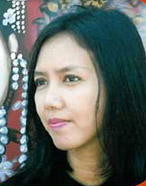 |
||
|---|---|---|
| CP Foundation | About CP Biennale | 2003 | 2005 | Contact Us | >||
           
|
||
|
With such paradoxes, Wara often presents the hidden "truth" of myths or life norms. In her painting Romeo dan Juliet, she depicts not only the meeting of pure love, but also the inherent passions. In our subconscious, we tend to think that love is always symbolized by a sweet couple. Wara Arindyah here presents love with an ironical symbol. Romeo and Juliet in this work are portrayed in the paradoxes of love. Anxiety is apparent in the male figure, while the female figure seems to be ecstatic in consuming their passion. Another figure, in the form of a monster, is haunting the male figure. The work might remind us to the myth of Adam and Eve. Another work, Menyentuh Dunia Damai (Touching the Peaceful World, 2003), depicts the ironies in a family life. A castle with a green lawn represents the peaceful life in a family. However, Wara thinks that behind the peace often exist conflicting realities. The portrayal of a stressful couple in the middle of the painting betrays such belief. Still, Wara says that the imaginary peace might provide some refuge from the omnipresent social cacophony. Previously, Wara often used pastel on paper, with themes about the ironies and the symbolical representations about grassroot lives. Even if the colors were strong and bright, her works in this period presented deformed, obese figures, full of mystery. Now Wara increasingly explores the mysterious, silent world. This is further strengthened by her use of heavy colorings and soft strokes in portraying her figures. The interpellation of the values she builds, therefore, is rooted in her personal experiences. M. Agus Burhan Born on August 25, 1969 in Magelang. SELECTED SOLO EXHIBITIONS SELECTED GROUP EXHIBITIONS |
||
|
CP foundation | About CP Biennale | 2005 Biennale | Previous Biennales | Biennale Catalogues | Contact Us
Jl. Suryopranoto 67A, Jakarta 10160, Indonesia. ph. +62.21.3448126, 3853206 | fax. +62.21.3853203, 3853208 info@cp-foundation.org |
||
 Wara Arindyah describes her creative processes, explaining that the figures in her painting are the result of some imaginative and dramatic hunts. Her painting process, therefore, is a turbulent activity in a silent world. The seemingly paradoxical phrase contains some truth, and her works reveal this paradox. The figures in her works are apparently in strains, their gestures seem theatrical, and they appear to be screaming. The figures, however, at once depict a fragment of a distant and silent world. The worries and the strains are always present in the facial expressions of the figures--even a smile seems more to pierce us with an eerie and alien grin. A lethargic world is depicted through skeletal and obese figures. In Wara's own life, however, a cozy domestic world of her family is strongly present, always with the often-conflicting passions of her creative urge and her love for her family. The paradoxes profoundly influence her inner life, triggered by her wild imaginations due to her voracious reading in literary works.
Wara Arindyah describes her creative processes, explaining that the figures in her painting are the result of some imaginative and dramatic hunts. Her painting process, therefore, is a turbulent activity in a silent world. The seemingly paradoxical phrase contains some truth, and her works reveal this paradox. The figures in her works are apparently in strains, their gestures seem theatrical, and they appear to be screaming. The figures, however, at once depict a fragment of a distant and silent world. The worries and the strains are always present in the facial expressions of the figures--even a smile seems more to pierce us with an eerie and alien grin. A lethargic world is depicted through skeletal and obese figures. In Wara's own life, however, a cozy domestic world of her family is strongly present, always with the often-conflicting passions of her creative urge and her love for her family. The paradoxes profoundly influence her inner life, triggered by her wild imaginations due to her voracious reading in literary works.